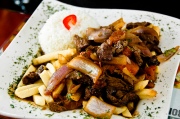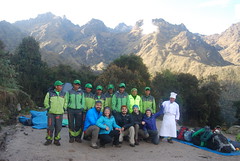By Julian Kircher
So you’re in a foreign country, everything looks and sounds and smells strange, nothing more so that the food. Fruit reminds you of the fruit back home but there is always some important difference: the colour is wrong, it’s too big or the wrong shape or smells funny. The good news however is that locals have been eating these things for a long time and most of them look almost alive and healthy. So we can assume the food here is safe and perhaps even delicious. Well let me try and convince you that with an open mind and empty stomach Cusco can be exceptionally rewarding. So I have compiled a sample menu that will rival any fancy French restaurant, except here you won’t find any snooty waiters floating around the place and you probably won’t be served swan lightly fried in unicorn tears and served on a bed of moonrock. Also the whole thing will cost you less than $10 and you will get to see and experience a handsome chunck of Cusco.
***
Where to start? Well you will want a hearty meal to start out with. San Pedro is the place to go for this. A bustling hive of vendors that sell fabrics and trinkets and most importantly food. Food of every sort is found here. Hidden away at the back of the market there is a large space where dozens of tiny food stalls, with a small rickety bench in front of them, serve food of all description. Most of these places will have set menus and for around 4 – 6 Soles you can get a starter (usually soup) and a choice of mains. Served with a little fruit juice. This is the authentic experience. You you will set next to the local workforce, enveloped by the steam and the sumptuous smells from hundreds of bubbling pots. This experience will make you feel like a local. Everything is made fresh and personally this is the one place where I have never gotten sick.
Now that your stomach has stopped rumbling you will want dessert. Remember you are on holiday so don’t count those calories. As such I have collected several post-meal options here because let’s face it: that is all we really wanted anyway. But before we become too unhealthy let us make a quick and nutritious stop. Fruit juices!
At the opposite end of San Pedro a horde of waving ladies wait patiently behind unstable looking mountains of fruit and vegetables. Ready to shred and blend any combinations of fruit possible. They will assist you in picking out delicious combinations. So far the following combinations have proven to be the best: banana, mango, strawberry as a milkshake with honey (this is the rich, creamy sweet option) if you want something else (although I don’t know why you would) then a combinations of strawberry, apple and orange or a combinations of banana, mango and papaya will give you slightly fruitier tastes. Juices are approx. 6-8 Soles.
Now we have assuaged our inner Nutritionist it is time to move onto something more unhealthy. Take a stroll behind the San Pedro market. There you will find a street with an army of vendors shouting and crying, their wares displayed at their feet. Among this bee hive of activities and noises you will find one or perhaps several Picarones stands.  This is what we have all been waiting for. Sweet dough made from sweet potatoes then quickly deep fried and covered in honey. Go on you’ve earned it. This deliciousness is made fresh in front of your eyes and the smell alone will remain with you for a long time. Around 2-4 Soles.
This is what we have all been waiting for. Sweet dough made from sweet potatoes then quickly deep fried and covered in honey. Go on you’ve earned it. This deliciousness is made fresh in front of your eyes and the smell alone will remain with you for a long time. Around 2-4 Soles.
Now you are probably almost full, your stomach may be hurting since you left self-control behind at San Pedro. Well then the answer is to stop off at an Emolientes stand. These pop up around evening time and you want have to walk long to find them. A small cart containing a big pot of hot water and about half a dozen bottles, each filled with a different coloured liquid. This cart looks more like a mobile improvised chemistry lab. Don’t shy away! These are all herbal infusions which are mixed, all together, with hot water and a bit of gelatin. This creates a very thick and herby concoction which will act as an internal heating system for you as well as aid with digestion. This is the least you can do for your poor stomach. Usually around 1 or 2 Soles.
Emolientes stand. These pop up around evening time and you want have to walk long to find them. A small cart containing a big pot of hot water and about half a dozen bottles, each filled with a different coloured liquid. This cart looks more like a mobile improvised chemistry lab. Don’t shy away! These are all herbal infusions which are mixed, all together, with hot water and a bit of gelatin. This creates a very thick and herby concoction which will act as an internal heating system for you as well as aid with digestion. This is the least you can do for your poor stomach. Usually around 1 or 2 Soles.
Well there you have it. My menu. Hopefully you are feeling as hungry as I am, luckily this is exactly what I will eat tonight, you will have to make the journey over here too in order to enjoy these culinary treats.
















 4 guinea pigs
4 guinea pigs
